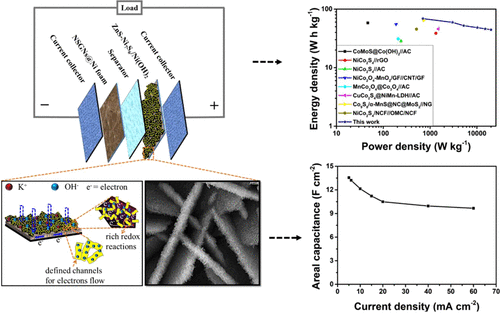当前位置:
X-MOL 学术
›
ACS Appl. Mater. Interfaces
›
论文详情
Our official English website, www.x-mol.net, welcomes your feedback! (Note: you will need to create a separate account there.)
ZnS–Ni7S6 Nanosheet Arrays Wrapped with Nanopetals of Ni(OH)2 as a Novel Core–Shell Electrode Material for Asymmetric Supercapacitors with High Energy Density and Cycling Stability Performance
ACS Applied Materials & Interfaces ( IF 8.3 ) Pub Date : 2020-09-29 , DOI: 10.1021/acsami.0c10638 Ghuzanfar Saeed 1 , Parthasarathi Bandyopadhyay 1 , Sachin Kumar 1 , Nam Hoon Kim 1 , Joong Hee Lee 1, 2
ACS Applied Materials & Interfaces ( IF 8.3 ) Pub Date : 2020-09-29 , DOI: 10.1021/acsami.0c10638 Ghuzanfar Saeed 1 , Parthasarathi Bandyopadhyay 1 , Sachin Kumar 1 , Nam Hoon Kim 1 , Joong Hee Lee 1, 2
Affiliation

|
Supercapacitors possess minimum energy density, lower rate capability, and inferior long-term cycling stability performance, and these issues have restricted their practical applications. In these circumstances, supercapacitors based on a new class of hybrid nanomaterial are strongly desirable. Herein, for the first time, a complex nanoarchitecture comprised of a ZnS–Ni7S6/Ni(OH)2 core/shell is constructed via a multistep hydrothermal process. The ZnS–Ni7S6/Ni(OH)2 core/shell nanoarchitecture illustrates a commendable areal capacitance of 13.55 F cm–2 at a lower current density value of 5 mA cm–2, respectively. The ZnS–Ni7S6/Ni(OH)2 core/shell hybrid nanomaterial maintains a high cycling stability performance of 95.12% after a maximum 10 000 number of cycles. Moreover, the asymmetric supercapacitor device made up of ZnS–Ni7S6/Ni(OH)2 and nitrogen–sulfur-codoped graphene nanosheets (NSGNs) delivers an ultrahigh energy density value of 68.85 W h kg–1 at a power density of 700.16 W kg–1. The cycling stability of the ZnS–Ni7S6/Ni(OH)2//NSGN asymmetric supercapacitor was performed and was 91.79% after 10 000 GCD cycles. The ZnS–Ni7S6/Ni(OH)2 core/shell hybrid electrode material has helped in promoting an asymmetric supercapacitor device with an elevated performance and can be considered as a potential electrode material to develop energy storage devices in the future.
中文翻译:

Ni(OH)2纳米花瓣包裹的ZnS–Ni 7 S 6纳米片阵列,作为新型核壳电极材料,用于具有高能量密度和循环稳定性的不对称超级电容器
超级电容器具有最小的能量密度,较低的倍率能力和较差的长期循环稳定性能,这些问题限制了它们的实际应用。在这些情况下,非常需要基于新型混合纳米材料的超级电容器。本文中,首次通过多步水热法构建了由ZnS–Ni 7 S 6 / Ni(OH)2核/壳组成的复杂纳米结构。ZnS–Ni 7 S 6 / Ni(OH)2核/壳纳米体系结构在较低的电流密度值为5 mA cm –2时分别具有13.55 F cm –2的值得称赞的面积电容。ZnS–Ni7 S 6 / Ni(OH)2核/壳杂化纳米材料在最多10 000次循环后仍保持95.12%的高循环稳定性能。此外,由ZnS-Ni 7 S 6 / Ni(OH)2和氮-硫共掺杂的石墨烯纳米片(NSGNs)组成的非对称超级电容器器件在功率密度为70瓦时可提供68.85 W h kg –1的超高能量密度值。 700.16 W公斤–1。进行了ZnS–Ni 7 S 6 / Ni(OH)2 // NSGN不对称超级电容器的循环稳定性,在1万次GCD循环后,其循环稳定性为91.79%。ZnS–Ni 7 S 6/ Ni(OH)2核/壳混合电极材料有助于提高性能的不对称超级电容器器件,并且可以被认为是将来开发储能器件的潜在电极材料。
更新日期:2020-10-21
中文翻译:

Ni(OH)2纳米花瓣包裹的ZnS–Ni 7 S 6纳米片阵列,作为新型核壳电极材料,用于具有高能量密度和循环稳定性的不对称超级电容器
超级电容器具有最小的能量密度,较低的倍率能力和较差的长期循环稳定性能,这些问题限制了它们的实际应用。在这些情况下,非常需要基于新型混合纳米材料的超级电容器。本文中,首次通过多步水热法构建了由ZnS–Ni 7 S 6 / Ni(OH)2核/壳组成的复杂纳米结构。ZnS–Ni 7 S 6 / Ni(OH)2核/壳纳米体系结构在较低的电流密度值为5 mA cm –2时分别具有13.55 F cm –2的值得称赞的面积电容。ZnS–Ni7 S 6 / Ni(OH)2核/壳杂化纳米材料在最多10 000次循环后仍保持95.12%的高循环稳定性能。此外,由ZnS-Ni 7 S 6 / Ni(OH)2和氮-硫共掺杂的石墨烯纳米片(NSGNs)组成的非对称超级电容器器件在功率密度为70瓦时可提供68.85 W h kg –1的超高能量密度值。 700.16 W公斤–1。进行了ZnS–Ni 7 S 6 / Ni(OH)2 // NSGN不对称超级电容器的循环稳定性,在1万次GCD循环后,其循环稳定性为91.79%。ZnS–Ni 7 S 6/ Ni(OH)2核/壳混合电极材料有助于提高性能的不对称超级电容器器件,并且可以被认为是将来开发储能器件的潜在电极材料。














































 京公网安备 11010802027423号
京公网安备 11010802027423号